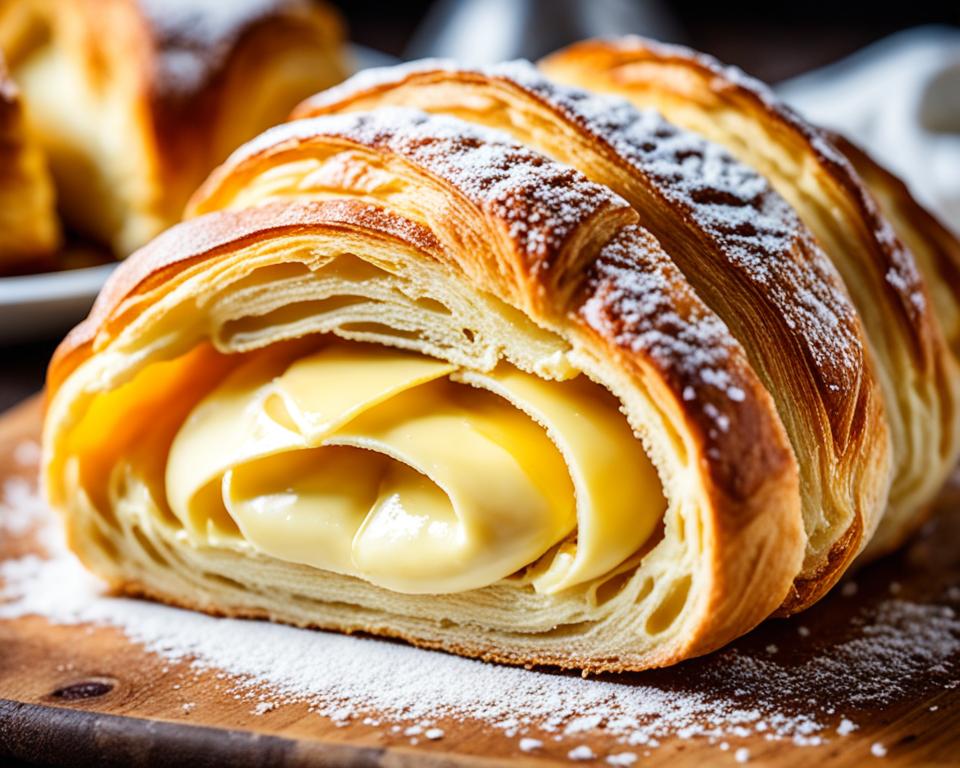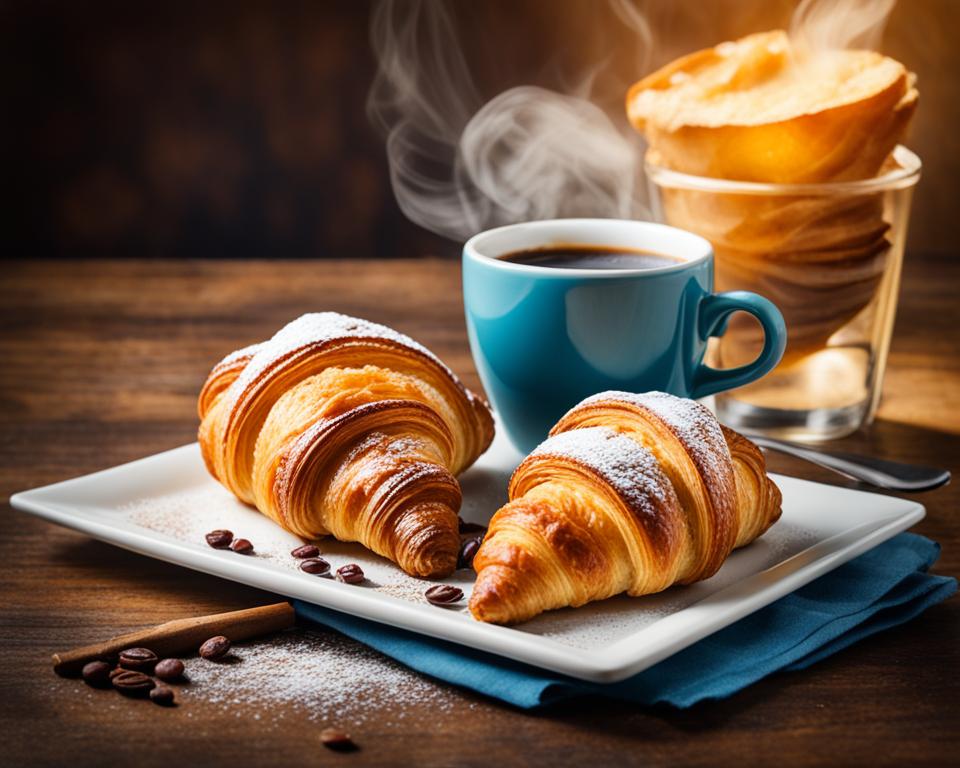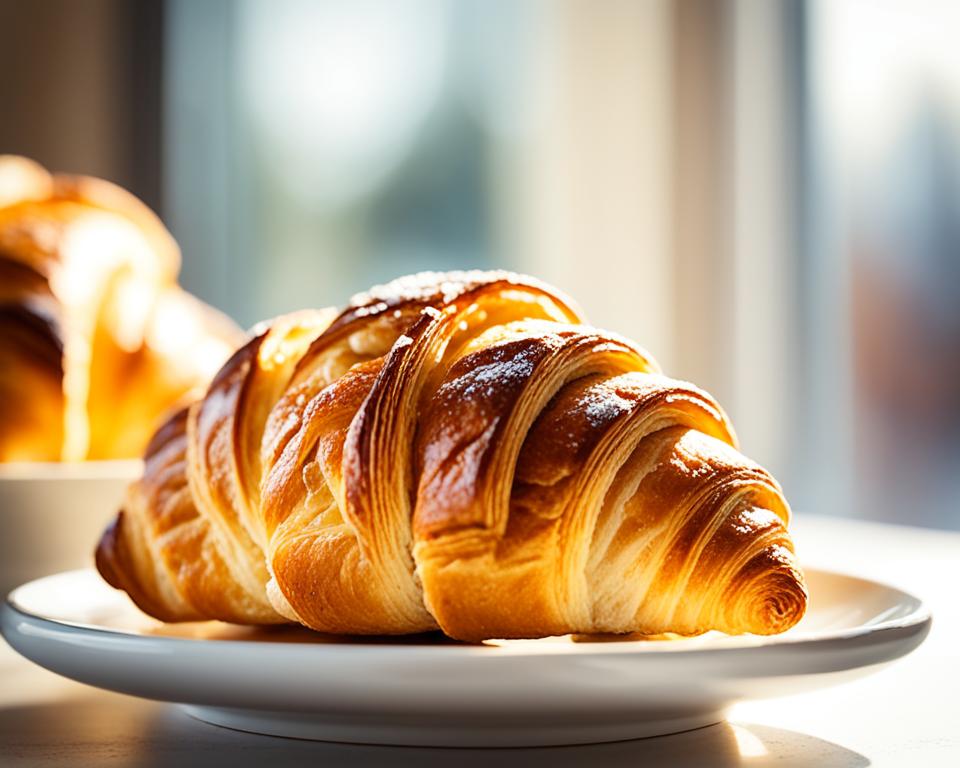Experience the charm of authentic French croissants, known for their flaky, buttery goodness. These pastries are made with great care and a deep respect for tradition. They delight with their rich, decadent taste and beautiful layers.
Learn how these treats go from simple ingredients to a feast for the senses. Discover the secrets that make croissants special. Every bite shows the skill and love of the bakers who have honed this craft over years.
Enjoy the buttery delight that has made French croissants loved worldwide. They are a cherished tradition.
Read interesting things at : legend-of-raphael
Key Takeaways
- Authentic French croissants are renowned for their flaky, buttery perfection.
- The intricate process of laminated dough is essential to creating the signature layers and texture.
- French croissants are a Parisian delicacy with a rich history and global appeal.
- Buttery flavor and a delicate balance of crunchy crust and soft interior define the quintessential croissant.
- Mastering the art of French pastry-making is a labor of love, passed down through generations.
The Art of French Croissant Baking
The art of French croissant baking is a tradition that needs skill in making the laminated dough. This dough is full of buttery layers. It turns simple ingredients into a flaky, buttery treat.
Mastering the Laminated Dough
A perfect French croissant starts with the laminated dough. It’s made of flour, butter, and yeast. Making this dough is a big job, needing many folds and turns to get the flaky crust.
The chef must watch the temperature and resting times closely. This helps the dough keep its layers and get the right texture.
The Quintessential Buttery Layers
The real taste of a French croissant comes from its buttery layers. As the dough is rolled and baked, the butter melts. This makes the flaky, delicious layers we all love.
This process needs a lot of care and patience. The chef must balance the dough and butter perfectly. This makes the viennoiserie texture we all know and love.
| Croissant Baking Process | Key Techniques |
|---|---|
| Laminated Dough Preparation |
|
| Butter Integration |
|
| Baking Technique |
|
The art of French croissant baking shows the hard work and skill of pâtissiers. They master the laminated dough and create the buttery layers. This brings out the best in this pastry baking tradition.
Origins of the French Croissant
The french croissant has a rich history tied to French culinary traditions. It’s often linked to Paris and its lively viennoiserie scene. But its roots come from a mix of cultures and influences.
The story goes back to the 13th century, when the crescent-shaped pastry was made in Vienna, Austria. It was to celebrate the victory over the Ottoman Empire. The shape was inspired by the Ottoman flag’s crescent moon, symbolizing victory.
In the 19th century, the french croissant became the treat we know today. French bakers took the Viennese recipe and added their own flair. They made it the flaky, buttery pastry we love today.
“The croissant is not just a pastry, it’s a piece of French cultural heritage.”
The rise of the french croissant matched the growth of Parisian cafes and a vibrant café culture. It became a favorite with morning coffee. This pairing has made the croissant a key part of Parisian life.
Now, the french croissant is loved worldwide, showing its lasting charm. Its move from a Viennese symbol to a Parisian favorite has made it a cherished part of French food culture.
French Croissant: A Parisian Delicacy
The french croissant is a key Parisian treat that has won over food lovers all over the world. It’s known for its flaky crust and buttery flavor. These qualities make it a standout in French food.
In the city of love, the french croissant is a symbol of elegance and style. Its layers of dough are carefully folded and rolled. This makes it have a texture that’s both delicate and indulgent.
Flaky Crust and Buttery Flavor
A top-notch french croissant is all about perfect texture and taste. The flaky crust comes from a special dough process. Inside, you’ll find a buttery interior that’s just divine.
It’s perfect for a fancy breakfast or a sweet afternoon snack. The french croissant is a key part of Parisian culture. It’s loved by both locals and tourists for its unique taste and charm.
The Perfect Breakfast Pastry
As the sun rises over Paris, the smell of French croissants fills the air. It calls people to try the best breakfast pastry. The butter croissant is a favorite in cafes, offering a rich start to the day.
The French croissant has a flaky, golden crust and a soft, buttery inside. Each bite is a mix of crisp and creamy flavors. It’s perfect with coffee or tea, whether you’re eating on the move or in a cozy cafe.
- Flaky, golden crust
- Soft, buttery interior
- Delightful balance of texture and flavor
- Ideal for a satisfying breakfast or mid-morning treat
The French croissant is loved for its history and the care put into making it. Every step, from the dough to the baking, is important for the perfect taste. This focus on quality makes the French croissant a favorite in Paris.
“The French croissant is not just a breakfast pastry, it’s a work of art – a delicate balance of flaky, buttery perfection that embodies the essence of Parisian cafe culture.”
People line up at the boulangerie, waiting for their butter croissant. This shows how much people love this Parisian treat. It’s a symbol of the city’s great food and a great way to start the day.
Viennoiserie: The French Pastry Tradition
Explore the deep history and traditions of viennoiserie, a French pastry type that includes the famous french croissant. This art of making pastries has grown from simple beginnings to being loved worldwide. It’s now seen as a top example of French cooking skill.
From Humble Beginnings to Global Acclaim
The story of viennoiserie starts in the 17th century. Austrian bakers brought a new kind of layered, buttery pastry to France. French bakers then made it even better, creating the french croissant we all enjoy today.
Now, the french pastry tradition is loved all over the world. The french croissant is known for its flaky outside and soft inside. It’s a sign of French cooking skill, loved by both pastry fans and those who just like to treat themselves.
“The french croissant is more than just a pastry; it’s a culinary masterpiece that embodies the rich heritage and artistry of the French baking tradition.”
Today, viennoiserie includes many tasty pastries, each with its own spin on the classic french croissant recipe. You can find everything from almond croissants to chocolate-filled ones. These pastries let you enjoy the classic French pastry tradition in new ways.
Butter: The Key Ingredient
At the heart of every authentic French croissant is a secret ingredient. This secret is butter. It makes the croissant flaky and gives it a rich, buttery taste.
The French are very picky about their butter. They choose the creamiest, best quality to make sure each croissant is perfect. Using top-notch butter is a tradition and shows French bakers’ commitment to quality.
| Butter Characteristics | Importance in French Croissants |
|---|---|
| High fat content (80-82%) | Contributes to the signature flaky, crisp texture |
| Creamy, smooth texture | Imparts a rich, indulgent mouthfeel |
| Unsalted variety | Allows the natural flavors of the butter to shine through |
Making French croissants is a labor of love. The careful use of butter is key. It’s added at every step, making sure it’s spread evenly. This creates the flaky layers that melt in your mouth.
“The secret to a truly exceptional French croissant lies in the quality and treatment of the butter. It is the very essence of what makes this pastry so irresistible.”
When you eat a freshly baked French croissant, you’ll notice the buttery flavor and the crunchy layers. This is thanks to French bakers’ skill in using butter in their croissants.

French Bakery Secrets Unveiled
Step behind the scenes of famous French bakeries to learn their secrets. Discover how they make croissant baking an art. They use special techniques, old recipes, and a lot of care to make French croissants loved by people all over the world.
They start with delicate dough layers and control the oven’s temperature perfectly. This makes the croissants flaky on the outside and buttery inside. Making French bakery treats is a tradition passed down through generations. Skilled bakers have made it their craft.
They use the best French butter and fold the dough in a special way. They also proof the dough at the right temperature and humidity. These steps make the French croissant a true work of art.
| Technique | Importance |
|---|---|
| Laminated Dough | Creates the signature flaky layers |
| Temperature Control | Ensures even baking and optimal texture |
| Butter Quality | Enhances the rich, buttery flavor |
| Proofing Process | Develops the perfect rise and structure |
Learn the secrets of the French bakery and the techniques behind the French croissant. Get ready to be amazed by the buttery delight that awaits.
Laminated Dough: A Labor of Love
Making the perfect French croissant starts with laminated dough. This process is a key part of pastry baking. It takes a lot of care and skill. The flaky layers and buttery taste come from folding and rolling the dough just right.
The Art of Folding and Rolling
Getting good at laminated dough shows a pastry chef’s skill. You layer butter with dough, then fold and roll it. This makes the croissant flaky and delicate. It’s important to do this carefully to get it right.
Getting the right balance between butter and dough is key. Too much butter makes the croissant greasy. Too little makes it dry. The goal is to get thin, even layers that will bake well.
For those who love pastry, making laminated dough is exciting. It’s a mix of folding, rolling, and resting. French bakers have made this technique perfect over time. It keeps the croissant a symbol of French cooking.
Pairing French Croissants with Coffee
The quintessential Parisian experience is enjoying a freshly baked french croissant with a rich, aromatic cup of coffee. This pairing creates a harmonious and indulgent breakfast. The buttery, flaky pastry and the robust coffee work together perfectly.
The delicate layers of the breakfast pastry contrast well with the smooth coffee. When you bite into the french croissant, its buttery richness meets the invigorating coffee. This mix awakens your senses with a symphony of flavors.
Whether you like your coffee bold or smooth, the french croissant enhances it. The richness of the pastry balances the coffee’s bitterness. This makes for a satisfying breakfast.
| French Croissant | Coffee Pairing |
|---|---|
| Buttery, flaky texture | Bold, intense brew |
| Delicate, layered pastry | Smooth, balanced flavor |
| Richness and indulgence | Bitterness and acidity |
Enjoying this classic Parisian pairing is a true culinary delight. It takes you to the charming streets of the City of Light with every bite and sip.

“The combination of a flaky, buttery french croissant and a rich, aromatic cup of coffee is the ultimate breakfast indulgence.”
Pastry Baking: A Culinary Adventure
Start a fun journey into pastry baking, where making French croissants is the top goal. Learn the detailed skills needed to make these famous Parisian treats. You’ll see how important the mix of ingredients, timing, and temperature is.
Mastering the Techniques
Baking viennoiserie, a French pastry tradition, is a big task. It takes a sharp eye and lots of patience. To get good at pastry baking, you need to know the science and add a bit of creativity.
Creating a great croissant starts with making a special dough. This dough is made by folding and rolling butter into it. Doing this right gives croissants their flaky layers and rich taste.
| Technique | Description |
|---|---|
| Lamination | The process of folding and rolling butter into the dough to create the signature flaky layers. |
| Proofing | Allowing the dough to rest and rise, ensuring the perfect texture and rise. |
| Shaping | Carefully forming the dough into the iconic croissant shape, maintaining the delicate structure. |
| Baking | Precisely controlling the temperature and baking time to achieve the golden-brown crust and tender interior. |
Every step in pastry baking needs focus, patience, and a good grasp of the science. Getting these techniques right is how you bring out the best in the French croissant.
Variations on the Classic French Croissant
The humble French croissant has become a canvas for bakers worldwide. They explore new flavors and techniques to make this pastry their own. From the classic butter croissant to new takes, the French croissant shows its versatility.
The almond croissant is a hit, with a layer of rich frangipane added to the dough. It combines buttery goodness with a sweet hint. This makes it a favorite among pastry baking fans.
Chocolate lovers adore the chocolate croissant. It has a rich chocolate filling inside the buttery layers. This version takes the French croissant to new heights, perfect for those who love both flaky pastry and chocolate.
The ham and cheese croissant offers a savory twist. It’s great for breakfast or brunch. The salty fillings mix well with the butter croissant‘s flaky outside, creating a delightful taste experience.
| Variation | Description |
|---|---|
| Almond Croissant | A layer of rich, nutty frangipane is added to the classic flaky dough. |
| Chocolate Croissant | A rich chocolate filling is nestled between the layers of buttery goodness. |
| Ham and Cheese Croissant | Savory fillings of ham and cheese complement the tender, flaky exterior. |
These are just a few ways the French croissant has evolved. They show the endless creativity in pastry baking. Whether you like the classic butter croissant or want something new, the French croissant always impresses.
“The French croissant is a canvas for culinary innovation, where tradition and creativity collide to create endless delicious possibilities.”
Conclusion: Indulging in Buttery Perfection
Your journey through the world of French croissants ends here, but the memory of their buttery taste stays with you. Think about the rich history and the special baking methods. These make the butter croissant a true work of art.
The French croissant is a big part of Parisian culture. It shows France’s dedication to making things by hand. From its beginnings in Vienna to today’s bakeries, the croissant has changed. But it still has that flaky outside and soft, buttery inside that everyone loves.
When you eat a warm, fresh French croissant, let the taste take you to Paris’s charming streets. The smell of fresh pastries fills the air, and life moves at a gentle pace. Enjoy every bite, and let it become a special memory. It’s a tribute to French cooking and the happiness of amazing baking.
